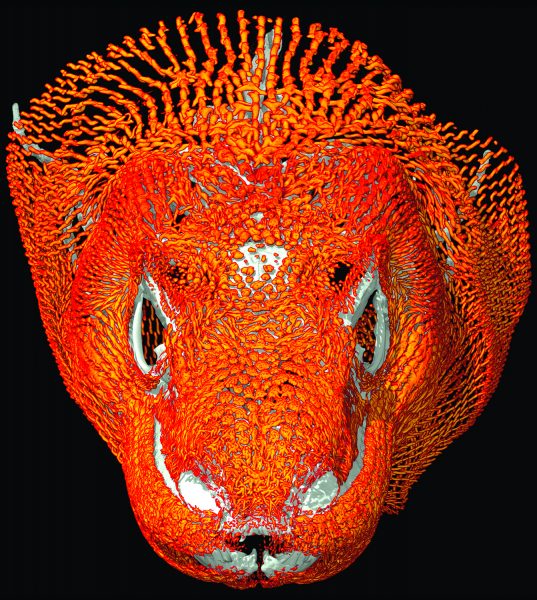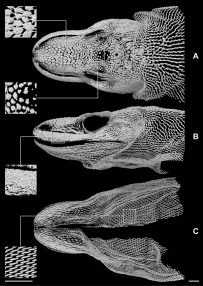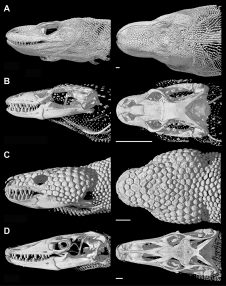Elaborate Komodo Dragon Armor Defends Against Other Dragons
September 12, 2019

Just beneath their scales, Komodo dragons wear a suit of armor made of tiny bones. These bones cover the dragons from head to tail, creating a “chain mail” that protects the giant predators. However, the armor raises a question: What does the world’s largest lizard – the dominant predator in its natural habitat – need protection from?
After scanning Komodo dragon specimens with high-powered X-rays, researchers at The University of Texas at Austin think they have an answer: other Komodo dragons.
Jessica Maisano, a scientist in the UT Jackson School of Geosciences, led the research, which was published Sept.10 in the journal The Anatomical Record. Her co-authors are Christopher Bell, a professor in the Jackson School; Travis Laduc, an assistant professor in the UT College of Natural Sciences; and Diane Barber, the curator of cold-blooded animals at the Fort Worth Zoo.
The scientists came to their conclusion by using computed tomography (CT) technology to look inside and digitally reconstruct the skeletons of two deceased dragon specimens – one adult and one baby. The adult was well-equipped with armor, but it was completely absent in the baby. It’s a finding that suggests that the bony plates don’t appear until adulthood. And the only thing adult dragons need protection from is other dragons.

Many groups of lizards have bones embedded in their skin called osteoderms. Scientists have known about osteoderms in Komodo dragons since at least the 1920s, when naturalist William D. Burden noted their presence as an impediment to the mass production of dragon leather. But since the skin is the first organ removed when making a skeleton, scientists do not have much information about how they are shaped or arranged inside the skin.“Young komodo dragons spend quite a bit of time in trees, and when they’re large enough to come out of the trees, that’s when they start getting in arguments with members of their own species,” Bell said. “That would be a time when extra armor would help.”
The researchers were able to overcome this issue by examining the dragons at UT’s High-Resolution X-ray Computed Tomography Facility, which is managed by Maisano. The lab’s CT scanners are similar to a clinical CT scanner but use higher-energy X-rays and finer detectors to reveal the interiors of specimens in great detail.
Due to size constraints of the scanner, the researchers only scanned the head of the nearly 9-foot-long adult Komodo dragon, which was donated by the Fort Worth Zoo when it passed away at 19½ years old. The San Antonio Zoo donated the 2-day-old baby specimen.

The CT scans revealed that the osteoderms in the adult Komodo dragon were unique among lizards in both their diversity of shapes and sheer coverage. Whereas the heads of other lizards examined by the researchers for comparison usually had one or two shapes of osteoderms, and sometimes large areas free of them, the Komodo had four distinct shapes and a head almost entirely encased in armor. The only areas lacking osteoderms on the head of the adult Komodo dragon were around the eyes, nostrils, mouth margins and pineal eye, a light-sensing organ on the top of the head.
“We were really blown away when we saw it,” Maisano said. “Most monitor lizards just have these vermiform (worm-shaped) osteoderms, but this guy has four very distinct morphologies, which is very unusual across lizards.”
The adult dragon that the researchers examined was among the oldest known Komodo dragons living in captivity when it died. Maisano said that the advanced age may partially explain its extreme armor; as lizards age, their bones may continue to ossify, adding more and more layers of material, until death. She said that more research on Komodo dragons of different ages can help reveal how their armor develops over time – and may help pinpoint when Komodos first start to prepare for battle with other dragons.
The National Science Foundation funded the research.
For more information, contact: Anton Caputo, Jackson School of Geosciences, 512-232-9623; Monica Kortsha, Jackson School of Geosciences, 512-471-2241
